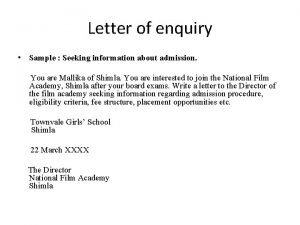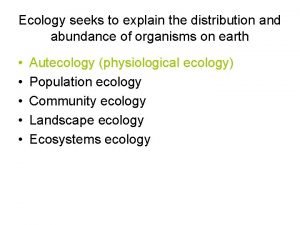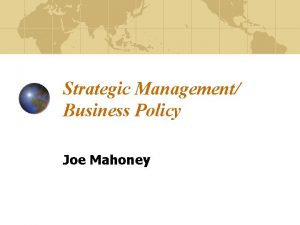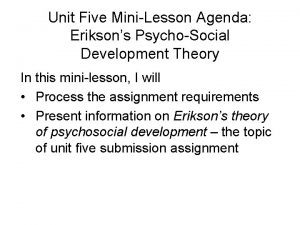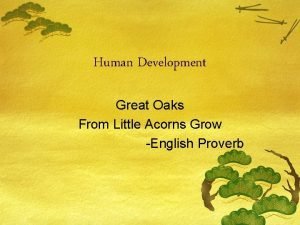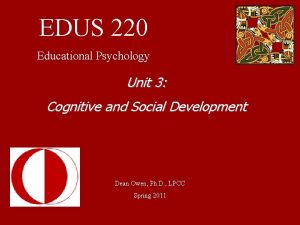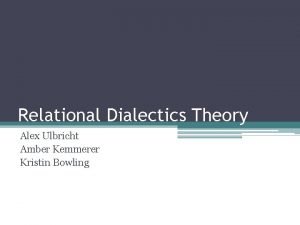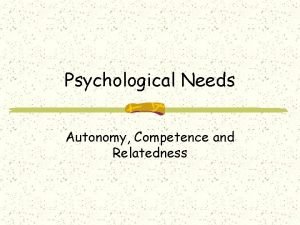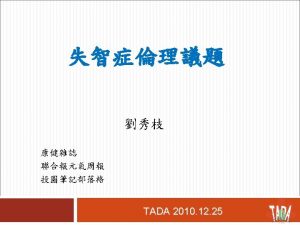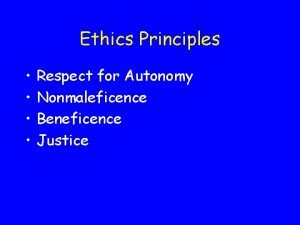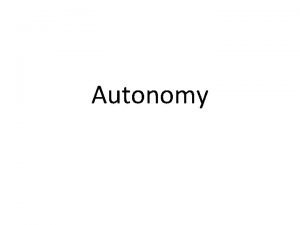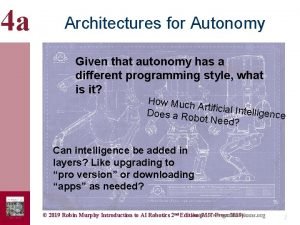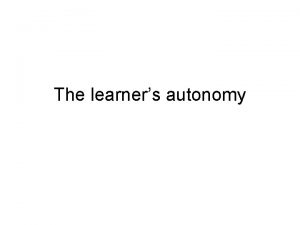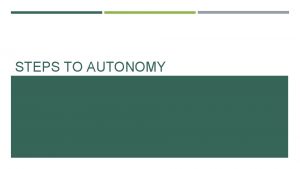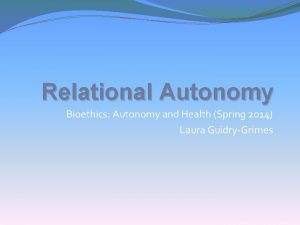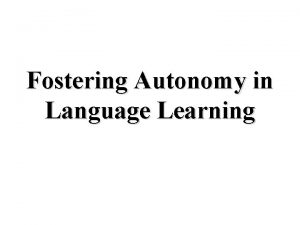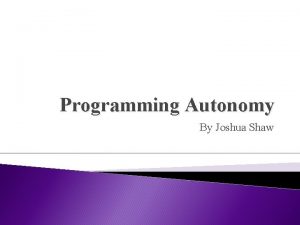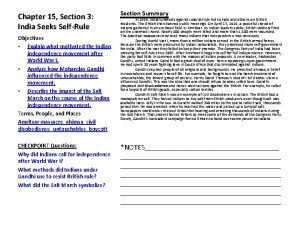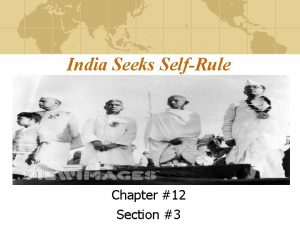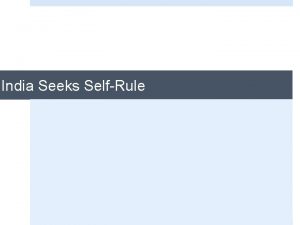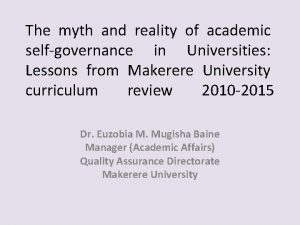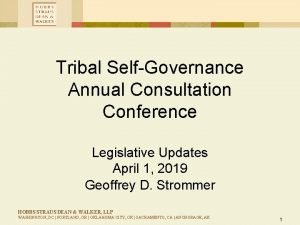17 2 India Seeks Autonomy selfgovernance Review India
























- Slides: 24

17. 2 - India Seeks Autonomy- self-governance

Review- India • Geography- Peninsula jutting out into Indian Ocean Himalayan Mountains to the NE (separating from China) Major Rivers: Indus and Ganges • Religion- Hinduism and Buddhism both started in this region • History- The Mughal Empire was powerful and featured rulers like Akbar the Great. -The British exploited the Indians, forcing them to grow cash crops like opium, indigo and cotton. -Indian men joined the Sepoy army to earn money, but their religious beliefs were ignored leading to the Sepoy Mutiny

India in WWI • Millions of Indians served for the British military in WWI • Britain had promised the Indians greater self-government in return for their service • But at end of WWI, only minor reforms were enacted, and the British continued to disregard Indian culture and beliefs

Indian National Congress Party • Educated Indians organized the Indian National Congress (Congress Party) in 1885 to work for self-rule within the British Empire • Wanted to stay in trading umbrella but make their own laws • Believed in peaceful protest to achieve their goals • After WWI, began pushing for independence

Muslim League • Though India’s population is mostly Hindu, there are millions of Indian Muslims as well • The Congress Party promised to work for all Indians, but the Muslim minority felt their needs were largely ignored and worried that a Hindurun government would oppress them • In 1906, the Muslim League was created to look out for Muslim interests • The Congress Party and Muslim League worked well together at first, but soon their goals diverged

Indian Nationalist Leaders Muhammad Ali Jinnah -Muslim League leader -Worked to safeguard the injuries of Muslims in India -Pushed for full independence Mohandas Gandhi -Leader of the Congress Party -Wanted to stay in the Empire -Western Educated lawyer -Fought for equality in South Africa

Mohandas Gandhi • Born to a middle-class Hindu family, studied law in England, moved to South Africa and fought unfair laws • During his time in South Africa, Gandhi developed a method of passive (non-violent) resistance, and called it satyagraha, or “soul force” • Gandhi was able to unite Indians across class lines to work for a common goal • Admirers called him Mahatma, or “Great Soul”

Resentment Grows • The British continued to exploit India and force unequal social policies, and Indians began to grow restless • By 1918 protests were common, leading the British to ban public gatherings of natives • In 1919, the British passed the Rowlatt Act, which allowed them to arrest any Indian citizen suspected of disobeying the government (or encouraging others to) and then try them without a jury

The Amritsar Massacre • In April 1919, a large peaceful protest group gathered in an enclosed field in Amritsar. Most of the protesters did not know that public meetings had been outlawed • British commander General Reginald Dyer surrounded the only entrance to the field with his troops and ordered them to fire into the crowd. For ten minutes the troops fired into a crowd that was trapped by walls on all sides. • 379 men, women and children were killed, and over 1100 more were wounded “My intention was to inflict a lesson, that would have an impact throughout India” General Dyer

Gandhi’s Philosophy • After the Amritsar Massacre, Gandhi began to push for full autonomy from Britain. He was horrified by the massacre, but also condemned reactionary violence, and used peaceful measures to gain Indian freedom • Civil Disobedience- refusal to obey unjust laws • Untouchables- Gandhi embraced the lowest caste of Indian society, calling them Harijans, or “children of God” • Boycott- refusal to buy British goods, especially cotton textiles • Made the spinning wheel the symbol of the independence movement

Leading by Example • Gandhi pushed Indians to challenge British rule & fight for independence, & he led by example- doing what he wanted others to do • Abandoned western-style clothing for the dhota, a simple white garment traditionally worn by village Indians • When protests became violent, Gandhi would fast, pray, and urge Indians to practice control • His campaigns gained widespread support and captured worldwide attention

Civil Disobedience • Gandhi felt several Indian laws were unjust, such as the salt laws • The British claimed the sole right to produce and sell salt, and taxes on it allowed them to maintain their government in India • In early 1930, Gandhi wrote to the British viceroy stating his intention to break the salt laws • By taking a stand against what he saw as a symbol of British oppression, Gandhi hoped to mobilize mass support What is civil disobedience? Disobeying laws that are unjust or unfair Viceroy- ruler exercising authority in a colony on behalf of a foreign government

The Salt March • On March 12, 1930, Gandhi set out with 78 followers on a 240 mile march to the sea • As they traveled, more and more people responded to Gandhi’s message, and by the time they reached the sea, there were thousands of marchers • Gandhi waded into the water, picked up a lump of sea salt, and was promptly arrested • Other Indians followed his lead, and soon thousands of Indians were in prison for breaking the salt laws • Hundreds were beaten as they attempted to get salt…none of them raised a hand in defense

World Opinion • Around the world, newspapers criticized Britain’s harsh response to peaceful protests • When a group of protestors tried to enter a salt works factory, an American journalist was there to witness how “not one of the marchers even raised an arm to fend off the blows” from the police • Britain, embarrassed, was forced by Gandhi’s campaign to hand over some power to the Indians, and agreed to meet other demands of the Congress party

World War II • Unfortunately, the start of the Second World War in 1939 postponed India’s quest for independence • Once again, millions of Indians joined in the war effort on behalf of Britain • When the war ended in 1945, India’s independence could no longer be delayed

Hindu vs Muslim • As India’s independence became a reality, conflicts between the majority Hindus and minority Muslims grew Hint- simplify and put in your own words • The Congress Party and Muslim League had been working together to gain independence, but now the Muslim League demanded the creation of a separate nation, Pakistan, where the majority of Indian Muslims lived

India and Pakistan Partitioning- splitting up or separating Independence was granted to both India and Pakistan in August 1947

Violent Migrations • As soon as the new borders were established, mass migrations took place. Hindus and Sikhs fled to the new India. At the same time, millions of Muslims fled from India to newly created Pakistan. • As millions moved between Pakistan and India, massacres occurred along the crowded roads. Around 1 million people died in these massacres, with many more dying of starvation and malnutrition.

Gandhi’s Response • Gandhi was horrified by both the partition and the violence that was taking place, and turned once more to satyagraha (nonviolent resistance). • On January 30, 1948 Gandhi was assassinated by a Hindu extremist who was enraged by Gandhi’s efforts to negotiate with Muslims. • Over 1 million people followed his funeral procession, and his death was the motivating factor that helped to end much of the violence

Review Which action is most closely associated with Ataturk (Mustafa Kemal)? 1) 2) 3) 4) Beginning the Zionist movement Starting the Palestine Liberation Organization Using Western practices to modernize Turkey Enforcing Islamic law


Review Mohandas Gandhi is most closely associated with the 1) support of violence and terrorism to end British rule 2) desire to strengthen the caste system 3) use of civil disobedience to gain political freedom 4) establishment of a national religion in India

Review During the Indian independence movement, the activity shown in this photograph inspired the Indian people to 1) stop buying British goods 2) reject Muslim rule 3) join the Indian army 4) expand British textile manufacturing

Review “Gandhi Calls for Boycott of British Textiles” “Gandhi and Followers Complete March to the Sea” “Gandhi Begins Hunger Fast” These headlines reflect Gandhi’s belief in 1) nonalignment 2) appeasement 3) isolationism 4) nonviolence
 India seeks self-rule
India seeks self-rule Lesson 2: india seeks self-rule
Lesson 2: india seeks self-rule Africa seeks a better future
Africa seeks a better future Seek wise counsel
Seek wise counsel An email seeking admission information
An email seeking admission information God is looking for true worshippers
God is looking for true worshippers Sometimes whoever seeks abroad
Sometimes whoever seeks abroad What passages in the poem explain why the seafarer seeks
What passages in the poem explain why the seafarer seeks The devil comes to kill steal and destroy niv
The devil comes to kill steal and destroy niv Population of earth
Population of earth A transnational corporate-level strategy seeks to achieve
A transnational corporate-level strategy seeks to achieve Benchmarks are baseline values the system seeks to attain
Benchmarks are baseline values the system seeks to attain Maladaptation of intimacy vs isolation
Maladaptation of intimacy vs isolation Love vs autonomy in jane eyre
Love vs autonomy in jane eyre People dying
People dying Pengertian beneficence
Pengertian beneficence Muscular anal stage
Muscular anal stage Psychosocial development
Psychosocial development Autonomy versus shame
Autonomy versus shame Autonomy vs. shame and doubt
Autonomy vs. shame and doubt Relationship dialectics theory
Relationship dialectics theory Autonomy competence and relatedness
Autonomy competence and relatedness Generativity stage
Generativity stage Nonmaleficence
Nonmaleficence Non maleficence beneficence autonomy justice
Non maleficence beneficence autonomy justice




